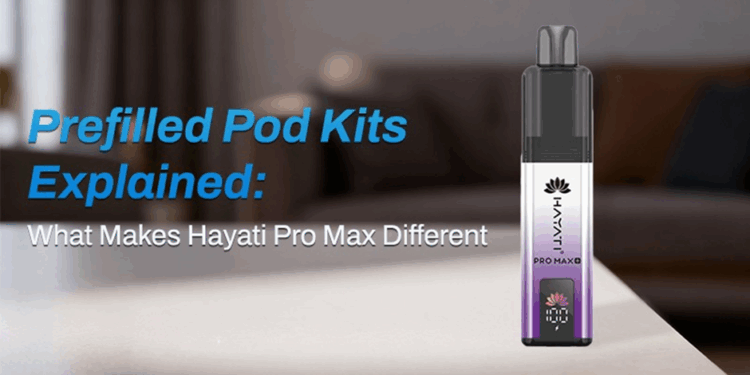Understanding the Technology Behind Consistent Vaping
Prefilled pod kits have become increasingly popular in the UK vaping market. But not all prefilled systems are created equal. The technology behind them, the design choices, and the engineering matter significantly to your actual vaping experience.
This guide breaks down what makes certain prefilled pod systems work better than others, using the Hayati Pro Max Plus as a case study in smart design. The Hayati Pro Max vape range represents genuine innovation in how prefilled systems should work, and the Hayati Pro Max Plus pods deliver on that promise consistently.
The Evolution of Prefilled Pods: From Simple to Sophisticated
First Generation: Basic Prefilled Pods
Early prefilled pod systems followed a simple model: fill a 2ml pod, insert it into a battery, vape until empty, swap for a fresh pod. Repeat. This approach worked and was convenient compared to refillables. But it created real problems.
Users faced constant pod changes (15 to 30 per month), flavour degradation over the pod’s lifespan, waste accumulation, limited control over nicotine strength, and no visibility into remaining capacity. Every time someone swapped a pod, coil degradation reset but so did battery connection risk. More packaging waste was generated. More money was spent. More opportunities for human error happened.
For a moderate vaper using 200 to 400 puffs daily, this meant changing pods every 1 to 2 days. That is roughly 180 to 365 pod changes per year. The technology was convenient but inefficient.
Second Generation: Addressing the Capacity Problem
The Hayati Pro Max Plus represents a completely different approach. Instead of a single 2ml pod, the Hayati Pro Max Plus uses dual chambers: a 2ml active pod where vaping actually occurs and a 10ml internal cartridge that feeds the active pod automatically. Total capacity is 12ml. This changes the user experience fundamentally.
Dual Chamber Design: Engineering for Real-World Use
With 12ml capacity, moderate users are looking at one pod change every 5 to 7 days instead of every 1 to 2 days. That is approximately 52 to 73 pod changes per year instead of 180 to 365. Numerically, that is an 80% reduction in refill frequency.
Fewer pod changes means less packaging waste, lower annual cost per user, reduced opportunity for installation error, more consistent user experience, and better convenience factor. The auto-refill system is the key mechanism. As the active 2ml pod is vaped from, liquid automatically feeds from the 10ml cartridge below. This is not manual refilling (which requires bottles, risk of spilling, and user responsibility). It is an automatic feed system.
Users never need to think about it. They simply vape until the Hayati Pro Max pods are depleted, then swap the entire unit. This simplicity is why the Hayati Pro Max Plus pods have gained such loyal followings.
Coil Technology: Mesh vs Standard
The coil inside a prefilled pod is where the actual vaporisation happens. Coil design significantly impacts consistency, flavour quality, and pod longevity.
Traditional prefilled pods use a single wire wound around cotton or similar material. The wire heats, the cotton absorbs and releases e-liquid, and vaporisation occurs. This approach has simple manufacturing (low cost), is effective for initial uses, but is prone to hot spots. Flavour degrades noticeably after 5 to 7 days. Spitting and popping are common issues.
The Hayati Pro Max vape range uses a mesh design instead. Multiple contact points distribute heat across a larger surface area. This creates even heat distribution, longer effective pod lifespan, reduced spitting and popping, consistent flavour throughout pod life, and more efficient e-liquid vaporisation.
With standard coils, some parts of the cotton experience significantly higher heat than others. This causes localised over-vaporisation (spitting), inconsistent throat hit, variable flavour intensity between puffs, and cotton degradation at hot spots. Mesh coils spread heat evenly. Cotton exposure is uniform. Vaporisation is consistent. Puff-to-puff experience remains stable.
In standard coils, flavour degradation becomes noticeable after day 4 or 5. Users report “washed out” taste by day 6 or 7. Mesh coils extend this window significantly. Users report consistent flavour through day 7 and beyond with the Hayati Pro Max Plus pods. This is measurable. It is not subjective.
Capacity and Performance: The Extended Consistent Zone
One overlooked benefit of the Hayati Pro Max design is the extended “performance window.” Most prefilled pods follow a degradation curve: Days 1-3 show peak performance at 100% flavour with strong throat hit. Days 4-5 show noticeable fade at 75-80% flavour with reduced throat hit. Days 6-7 show significant degradation at 60-70% flavour with diminished experience.
The Hayati Pro Max Plus, using mesh coils and larger total capacity, extends the peak performance window dramatically. Days 1-4 maintain peak performance at 95-100% flavour consistency. Days 5-7 show minimal fade at 85-90% flavour. Days 8+ only show noticeable decline if extended use is attempted.
Users experience better flavour consistency across more of their vaping month. This is why the Hayati Pro Max flavours have such a strong reputation for staying consistent throughout the pod’s lifespan.
Nicotine Delivery: Nic Salts and MTL Design
The Hayati Pro Max uses 20mg nic salt with a mouth-to-lung (MTL) draw profile. Nic salts absorb more efficiently into the bloodstream than freebase nicotine. At higher concentrations (20mg), they deliver satisfying nicotine levels without harsh throat hit. This is why they are preferred for MTL systems aimed at smokers transitioning to vaping.

MTL (mouth to lung) replicates traditional smoking. Vapour is drawn into the mouth first, then inhaled into the lungs. This is closer to how cigarettes work. Contrast this with DTL (direct to lung), where vapour is drawn directly to the lungs. DTL produces larger clouds. MTL produces smaller clouds with more concentrated flavour. For users transitioning from smoking, MTL is significantly more satisfying.
The Hayati Pro Max Plus is specifically designed for MTL use. The pod resistance, airflow restriction, and 20mg nic salt are optimised for this profile. Users attempting DTL will not get optimal experience.
Build Quality and User-Facing Features
Beyond internal engineering, several design elements impact daily usability. The transparent tank allows users to see remaining e-liquid level. This reduces anxiety about running out unexpectedly, allows users to plan pod changes, provides peace of mind during the day, and prevents over-draining a pod.
The LED screen shows battery percentage and puff count. This information allows users to plan charging around their schedule, understand consumption patterns, avoid dead battery situations, and track usage trends. USB-C charging is faster and more reliable than older standards. 30 minutes to full charge is practical for daily use.
The pod design minimises liquid leakage. Connections are secure. The fit between battery and pod is tight. This reduces mess, waste, and damaged devices.
Cost Analysis: Value Proposition
Understanding the cost structure helps users evaluate whether this system represents good value. Standard prefilled pods (2ml) cost 4 to 5 pounds per pod with 600 puffs, working out to 0.67 to 0.83 pence per puff.
Hayati Pro Max Plus pods (12ml capacity, 6000 puffs) typically cost 20 to 24 pounds per pod (equivalent) with 6000 puffs, working out to 0.33 to 0.40 pence per puff. The Hayati Pro Max Plus delivers 40-50% lower cost per puff.
For a moderate user (300 puffs daily): 10,950 annual puffs using standard 2ml pods costs approximately 65 to 72 pounds annually in pods alone. Using Hayati Pro Max Plus pods costs approximately 36 to 44 pounds annually. That is 21 to 36 pounds per year saved. Add initial device cost (35 to 45 pounds), and payback occurs within one to two months of regular use.
Limitations and Trade-offs
No system is perfect. The Hayati Pro Max Plus comes in 20mg only. Users wanting lower nicotine strengths cannot use this system. Users wanting higher strengths cannot either (though 20mg is near the legal UK maximum).
Users are limited to official Hayati Pro Max Plus pods and Hayati Pro Max flavours. There are 30+ options, but users cannot use other brand e-liquids. Some users prefer this consistency. Others find it limiting.
The device requires minimal maintenance, but some care is necessary: wipe contacts occasionally, store upright, avoid extreme temperatures, and do not leave in direct sunlight. Neglecting these will shorten device lifespan.
Conclusion: Design Philosophy in Action
The Hayati Pro Max Plus represents a thoughtful approach to prefilled pod design. It is not revolutionary. It is evolutionary. The dual-chamber design reduces refill frequency by 80%. The mesh coil extends the performance window and improves flavour consistency. The LED display and transparent tank enhance usability. The USB-C charging and TPD compliance address practical concerns.
These are not flashy innovations. They are engineering decisions that improve the user experience in measurable ways. For users prioritising consistency, convenience, and value, the Hayati vape design philosophy delivers genuinely on all fronts.
Important: Purchase From Trusted Online Vape Stores
When purchasing Hayati Pro Max Plus pods or any Hayati Pro Max vape products, always buy from trusted, authorised online vape retailers. The vaping market unfortunately has counterfeit products in circulation. Purchasing from reputable shops ensures you receive genuine Hayati Pro Max Plus pods with proper quality control, accurate nicotine content, verified safety standards, and proper TPD compliance documentation.
Trusted online vape stores stock authentic Hayati Pro Max flavours, genuine Hayati Pro Max pods, and legitimate Hayati vape devices. They provide proper age verification, clear product information, and customer support. Avoid unmarked sellers, suspiciously cheap options, or retailers without clear contact information. Your vaping experience depends on genuine products from legitimate sources.






















































